Explainer
- Explainer
- Lebanon
Glamour and destruction live side by side in Beirut. But has it finally reached breaking point?
From swish cafes and arty parties to assassinations and all-out war, Lebanon's capital has seen it all in the past 100 years. Now the nation is broke, its people desperate. How did this complex country become so stricken? And what will happen next?
The explosion that shook the port of Beirut on August 4 – after a stockpile of more than 2700 tonnes of ammonium nitrate was ignited – rocked Lebanon, killing 200 people, wounding thousands more and leaving 300,000 people without safe homes. On August 10, it also claimed the Lebanese government, which resigned over the disaster.
But the nation's grievances go back further than this blast, further even than the protests against the political class that made headlines last October – arguably to the nation's founding 100 years ago.
Why are people so angry? How has the trouble evolved in Lebanon? And what is likely to happen next?
What is Lebanon?
Before anything else, Lebanon is a geography. Running down the centre of this landscape is Mount Lebanon and the mountain range named after it. To the west is the Mediterranean coast with its ports, chief among them the capital Beirut, which for centuries have traded with the Mediterranean and wider world. To the east is the rural hinterland of the Bekaa Valley, a fertile plain that ends at the Anti-Lebanon mountain range (this rather peculiar name just means it runs parallel to the Lebanon Mountains). The whole area is 10,452 square kilometres: a little larger than metropolitan Melbourne but smaller than metropolitan Sydney.
In this landscape live 6.8 million people from a bewildering array of religious and ethnic groups, speaking to one another in Arabic but each with a very different understanding of what Lebanon means.
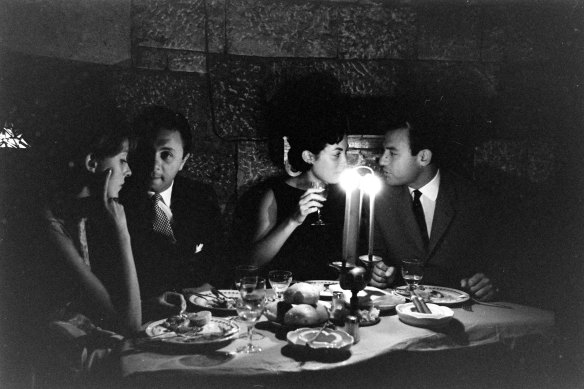
Dining in Beirut, 1961.Credit: Getty Images
What is Beirut?
It used to be said in the Arab world that "Cairo writes, Beirut publishes and Baghdad reads". Beirut is Lebanon's face to the world, a cosmopolitan space in which, during the 19th century, the salon culture of French colonisers and the building of schools by American missionaries influenced and was influenced by a renaissance in Arab literary and political culture as Ottoman rule waned.
The city became a place … where authors, artists, filmmakers and musicians could find an outlet for their work.
The city – known as Sitt al-Dunya, or "the Lady of the World" – became a place outside the censorship and repression of other Arab regimes, where authors, artists, filmmakers and musicians could find an outlet for their work and the press flourished.
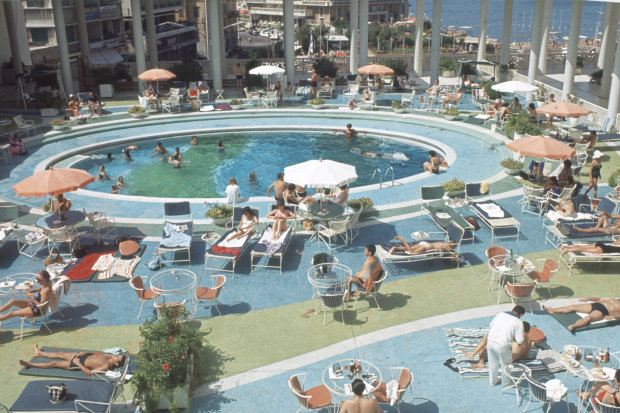
A hotel swimming pool in Beirut, 1965.Credit: Getty Images
Its comparative liberalism meant that in addition to tourists, it drew refugees and dissidents from other parts of the Arab world and even other Lebanese from their isolated mountain villages. In recent years it has also seen the first serious re-evaluation of gay and lesbian rights in the Arab world.
But as the author Tarek Osman put it recently, being the place where people from across the region came "to think, to talk and to play" also made it a target and a place for settling scores through wars and assassinations – and Beirut has seen many of both.
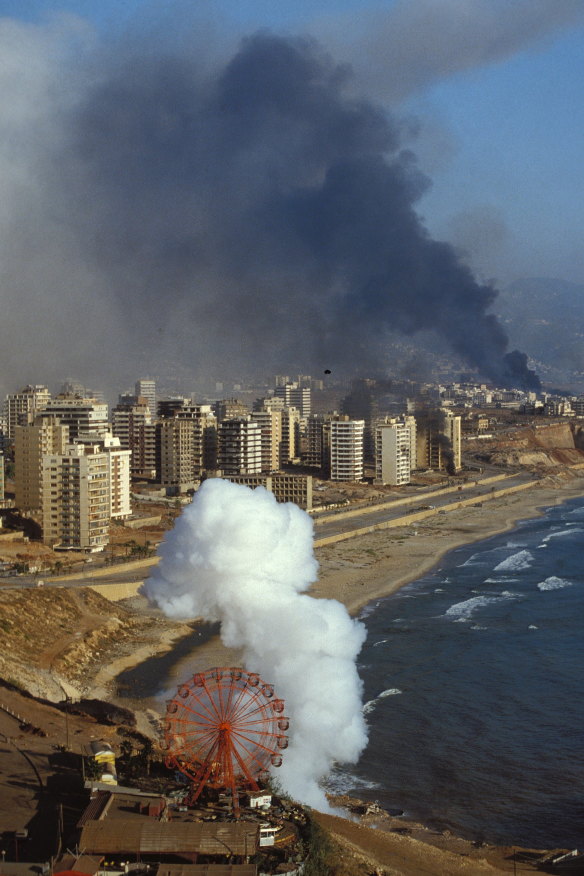
Beirut is bombed by Israeli forces during war in 1982. Credit: Getty Images
Lebanon is also a frontline state in the conflict between Israel and the Palestinians, with Palestinian attacks on Israel launched from its territory and repeated invasions and attacks by Israel, most notably in 1978 and 1982, continuing to this day. Palestinians who fled north during the Arab-Israeli war of 1948 still live in refugee camps across the country, barred from citizenship and many professions.
Many Lebanese blame the country's wars since 1970 on the presence of Palestinian militants in these refugee camps. In 1969, Egypt brokered the Cairo Agreement between Palestinian leader Yasser Arafat and the Lebanese army, which allowed the Palestinian factions to govern the camps and continue their armed struggle against Israel from them, on the understanding (which later collapsed) that their militias would not contest the Lebanese state's power beyond the camps.
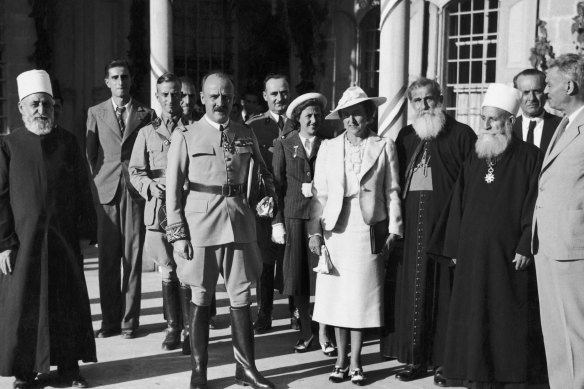
The French high commissioner in Lebanon with Druze and Maronite religious leaders, 1939.Credit: Getty Images
What do the French have to do with it?
France ruled Lebanon from 1920 until 1943.
Until World War I began in 1914, the part of the Middle East that includes Lebanon had been ruled for centuries with varying degrees of control by the Ottoman Empire from its capital in Istanbul. After the Ottomans chose the losing German side in that war, the Allies negotiated to divide its territory among themselves. Under the new League of Nations, Britain and France were awarded political "mandates" in the region, with London to run Iraq and Palestine and Paris to run Syria.
In 1920, France moved to divide its mandate, proposing a state on Syria's coast for minority Alawite Muslims, a state around Mount Lebanon for Maronite Catholic Christians and a state for the Druze sect. The rest of Syria would be dominated by the Sunni Muslims who were Syria's majority. The Druze and Alawite states never took off, but French and Maronite power was sufficient to ensure that Lebanon remained separate from Syria, even after the last French troops left the country, three years after Lebanon became independent, on the last day of 1946. (French troops left Syria in 1946 too.)
Some Lebanese berated Macron for sitting down with "warlords" while others begged him to save the nation.
When French President Emmanuel Macron went walkabout in the ritzy and traditionally Christian district of Gemmayzeh in Beirut's east in a display of support after the port explosion, some Lebanese berated him for sitting down with "warlords" (more on them in a moment) while others begged him to save the nation. But France's influence in Lebanon is not what it was, a telling sign of which was that the president had to address his young Lebanese audience in English. Macron told them he would propose a "new political pact".
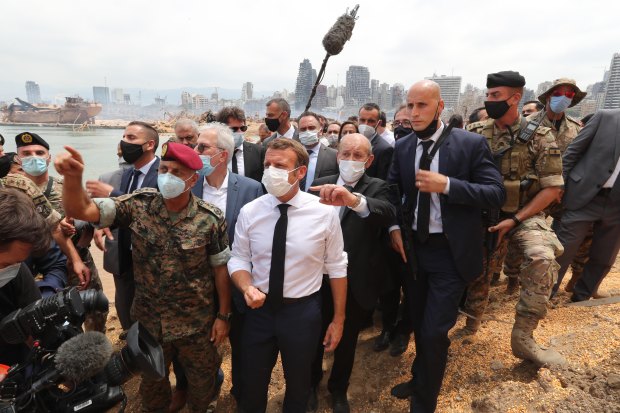
French President Emmanuel Macron inspects the site of the August 4 blast in Beirut.Credit: Getty Images
Is Lebanon's government secular or religious?
The short answer is "neither".
At the time of independence in 1943, its leaders drew up a National Pact which guaranteed each religious community seats in parliament according to their proportion of the population at the 1932 census, when Maronites were in the majority (but only just). The president of the republic would always be a Maronite Christian, the prime minister a Sunni Muslim and the speaker of parliament a Shiite Muslim.
Though the state is formally secular, laws on marriage, divorce and inheritance are governed by the religious leadership of each sect. (This arrangement has its origins in the Ottoman period, when each non-Muslim religious community, or "millet", had autonomy when it came to taxation and laws over personal status.) Like neighbouring Israel, Lebanon has no civil marriage, though it recognises civil marriages conducted abroad, which has made nearby Cyprus a popular wedding venue for citizens of both countries.
What is the difference between Sunni and Shiite Muslims?
The tensions that led to the split between Sunnis and Shiites first emerged during the lifetime of the Prophet Muhammad and in the aftermath of his death in AD 632.
The Sunnis, who call themselves Ahl al-Sunna wa al-Jamaa (the people of orthodoxy and the community), believed that any senior figure in the Muslim community could become Caliph (temporal and spiritual successor to Muhammad as leader of the Muslims).
The Shiites, who call themselves Ahl al-Bayt (the people of the house, ie. the house or family of the Prophet), believed that the Prophet's son-in-law and cousin, Ali, and his descendants had a special place as successors to the Prophet, or Imams. Although Ali was briefly Caliph himself, rule passed from him to a Sunni dynasty, the Umayyads.
The definitive split, which left Shiites politically marginalised and Sunnis as rulers for centuries, occurred in AD 680, when the Imam Hussein (a son of Ali) fell in battle with the forces of the Caliph Yazid I at Karbala, now in Iraq and a sacred Shiite site.
Today the world's largest Shiite population lives in Iran. That oil-rich country's 1979 Islamic Revolution overthrew the monarchy and brought a Shiite theocracy to power and since then many Shiites and some other Muslims in the Middle East have drawn political inspiration and financial support from Tehran. But 85 per cent of the world's Muslims identify as Sunni.
Though Lebanon's demographics have changed significantly – with the CIA estimating in 2019 that more than 60 per cent of the population are Muslim – there has not been a census since 1932. Tensions over this status quo were a major factor in the civil war between Maronite factions and their opponents that broke out in 1975 and ended in 1990 after the signing of the Taif Agreement, a Saudi-brokered renegotiation of the pact's quota system.
These 'tribal chiefs' … have far more bearing on policy than the parliament and successive governments.
It was during that war that thousands of Lebanese families sought refuge in countries such as Australia, where 1 per cent of the population now identifies as having Lebanese ancestry, according to the 2016 census, although other Lebanese families have been in Australia since the late 19th century.
The National Pact's effect has been to entrench the power of elite families and religious figures from the country's 17 official sects. These "tribal chiefs" maintain their power through the allocation of contracts and jobs within their communities and have far more bearing on policy than the parliament and successive governments. When their differences lead to open conflict, each of these "chiefs" relies on his party members as militia.
For two decades, the most powerful militia has been that of Hezbollah ("the Party of God"), which represents the country's Shiite Muslims.
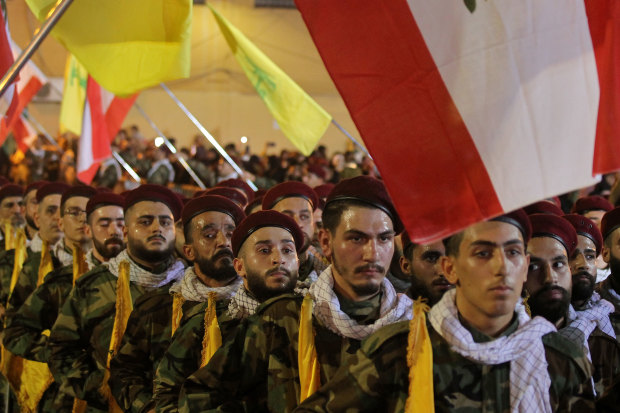
Hezbollah is the most powerful militia in Lebanon today. Credit: Getty
Why were people so angry even before the explosion?
The patronage system of the elites also involved owning shares in banks that lent money to their connections. Much of this money came from Lebanon's diaspora – emigres who, over the past 150 years, have set up commercially successful communities in Latin America, the United States, the Gulf monarchies and Australia. But oversight of the banking system was weak and there was no domestic base for repayment of this lending.
Matters were made worse by the 2006 war between Hezbollah and Israel and the 2011 uprising in Syria (in which Hezbollah fought for the Assad regime), both of which hit Lebanese income from tourism and discouraged investment from abroad. The ruling elites have moved an estimated $US100 billion out of the banking system and offshore, even as the country had to absorb more than a million refugees from the Syrian conflict.
Most parts of Lebanon are receiving only two or three hours of electricity a day.
The result is that the nation's currency has lost 60 per cent of its value in recent weeks, even as prices of staples (almost all of them imported) have rocketed. The explosion at the port destroyed the bulk of the country's supply of cereals, leaving it dependent on international aid. Most parts of Lebanon are receiving only two or three hours of electricity a day, and in the middle of a pandemic hospitals lack power, medicines and equipment. In March, the country defaulted on its debts – equivalent to 170 per cent of GDP.
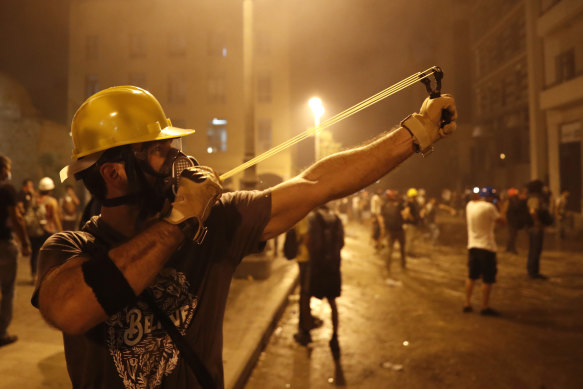
A recent street protest in Beirut.Credit: AP
Lebanese have been demonstrating in the streets about this state of affairs since October, and this week marked the second time a government has resigned in response. Since 2018, the International Monetary Fund has been offering a $US11 billion rescue package, but the elites have resisted terms that would include an audit of banks and a law to prevent capital flight.
What do Lebanon's people want now?
The cry of the masses during the "Arab Spring" of 2011 has been revived – rather than simply a new leader or government, protesters are calling for a complete restructuring of the political system that transcends sectarianism and vested interests, as in this video:
One of the most significant obstacles to such a revolution in Lebanon's affairs is what it would mean for the major powers in the region. For Iran, a Lebanon dominated by its fellow Shiites in Hezbollah is a crucial forward base in its power struggle with Israel. Yet many Lebanese believe the country's military should be the only armed force in the country and wish to see Hezbollah disarmed, a demand Hezbollah rejects out of hand as an attempt to return to the pre-civil war days of Maronite dominance and Shiite poverty and subjugation.
Saudi Arabia and its Arab allies are eager to see Hezbollah's powers (and through them Iran's) curbed, but fear any measure which extends the reach of democracy and transparency and ousts their own clients in the country.
For 15 years after the civil war Syria was, in effect, an occupying power in Lebanon until the 2005 protests against its rule that followed the assassination of former Lebanese prime minister Rafik Hariri in Beirut by a massive car bomb, one of a series of murders of Syria's critics at the time. For the Syrian regime, which depends heavily on Iran and Hezbollah, any shift in Lebanon is also guarded against.
The port explosion came on the eve of verdicts from a United Nations-led inquiry into that series of murders, in which four members of Hezbollah had been charged. Now there are calls for another international inquiry into the port blast itself, something Lebanese President Michel Aoun – a Maronite currently aligned with Hezbollah – has already rejected.
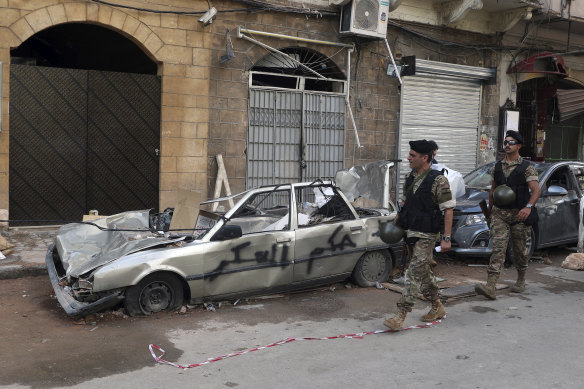
Soldiers walk past a car with graffiti in Arabic "Down with the military rule", near the site of the recent explosion in Beirut.Credit: AP
What is next?
The resignation of the government will generate more uncertainty and forming a new one could take months (gridlock in Lebanese politics meant the presidency was vacant from May 2014 until October 2016).
In the absence of any government to deal with, aid efforts will be hampered. The political vacuum could see all the regional players attempt to intervene to shape events in their favour, causing further inter-factional violence. And the collapse of the economy could see a fresh wave of emigration by many of Lebanon's brightest youth. Meanwhile, street protests that can turn violent now bring added danger: a surge of COVID-19 cases followed demonstrations over the port blast.
But the problems of the Lebanese political model – themselves a microcosm of the wider problems that sparked the "Arab Spring" – won't go anywhere, and neither will protesters' demands for a different order that can provide jobs, medical care and affordable basic goods, as well as rebuilding a shattered Beirut.
Get our Morning & Evening Edition newsletters
The most important news, analysis and insights delivered to your inbox at the start and end of each day. Sign up to The Sydney Morning Herald’s newsletter here and The Age’s newsletter here.
Let us explain
If you'd like some expert background on an issue or a news event, drop us a line at explainers@smh.com.au or explainers@theage.com.au. Read more explainers here.